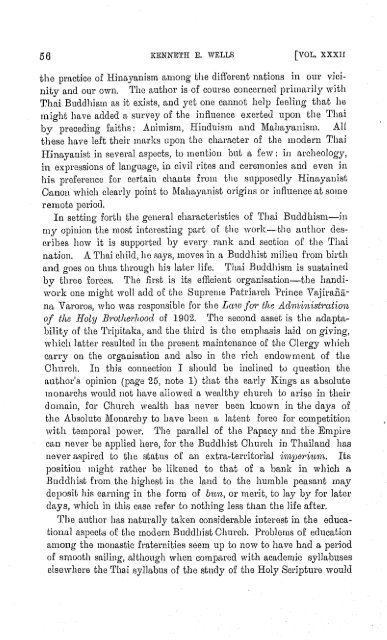The Journal of the Siam Society Vol. XXXII, 1940 - Khamkoo
The Journal of the Siam Society Vol. XXXII, 1940 - Khamkoo
The Journal of the Siam Society Vol. XXXII, 1940 - Khamkoo
Create successful ePaper yourself
Turn your PDF publications into a flip-book with our unique Google optimized e-Paper software.
56 KENNE'fH E. WELLS [VOL. <strong>XXXII</strong><br />
<strong>the</strong> pr11ctice <strong>of</strong> Hinayanism 111nong <strong>the</strong> different nations in our VJCInitv<br />
and our own. 'l'he author is <strong>of</strong> course concerned primarily with<br />
Th~i Buddhism 11s it exists, and yet one cannot help feeling that he<br />
might have added a. survey <strong>of</strong> <strong>the</strong> influence exerted upon <strong>the</strong> Thai<br />
by preceding faiths: Animism, Hinduism and Mah11yanism. AH<br />
<strong>the</strong>se have left <strong>the</strong>ir nmrks upon <strong>the</strong> chamcter <strong>of</strong> <strong>the</strong> modern Thai<br />
Hinayanist in several aspects, to mention but a few: in archeology,<br />
in expressions <strong>of</strong> language, in civil rites and ceremonies and even in<br />
his preference for certain chants from <strong>the</strong> supposedly Hinayanist<br />
Canon which clearly point to Mahayanist origins or influence at some<br />
remote period.<br />
In setting forth <strong>the</strong> general characteristics <strong>of</strong> 'l'hai Buddhism-in<br />
my opinion <strong>the</strong> most interesting pt1rt <strong>of</strong> <strong>the</strong> work-<strong>the</strong> author describes<br />
bow it is supported by every rank and section <strong>of</strong> <strong>the</strong> Thai<br />
nation. A Thai child, he srtys, moves in a Buddhist milieu from birth<br />
and goes on thus through his later life. Thai Buddhism is sustained<br />
by three forces. <strong>The</strong> first is its efficient organisation-<strong>the</strong> handiwork<br />
one might well add <strong>of</strong> <strong>the</strong> Supreme Patriarch Prince Vajiraiiana<br />
Varoros, who was responsible for <strong>the</strong> Law for <strong>the</strong> Aclnvinis-tration<br />
<strong>of</strong> <strong>the</strong> Holy Brothm'hood <strong>of</strong> 1902. 'rhe second asset is <strong>the</strong> adaptability<br />
<strong>of</strong> <strong>the</strong> hipitaka, and <strong>the</strong> third is <strong>the</strong> emphasis laid on giving,<br />
which lattm· resulted in <strong>the</strong> present maintenance <strong>of</strong> <strong>the</strong> Clergy which<br />
carry on <strong>the</strong> organisation and t1lso in <strong>the</strong> rich endowment <strong>of</strong> <strong>the</strong><br />
Church. In this connection I should be inclined to question <strong>the</strong><br />
author's opinion (page 25, note 1) that <strong>the</strong> early Kings as absolute<br />
monarchs would not have allowed a wealthy chmch to arise in <strong>the</strong>ir<br />
domain, for Chmch ·wealth has never been known. in <strong>the</strong> days <strong>of</strong><br />
<strong>the</strong> Absolute Monarchy to have been a latent force for competition<br />
with temporal power. <strong>The</strong> parallel <strong>of</strong> <strong>the</strong> Papacy and <strong>the</strong> Empire<br />
can never be applied here, for <strong>the</strong> Buddhist Church in Thailand has<br />
never aspired to <strong>the</strong> status <strong>of</strong> an extra-territorial imperi1~?n. Its<br />
position might ra<strong>the</strong>r be likened to that <strong>of</strong> a bank in which a<br />
Buddhist from <strong>the</strong> highest in <strong>the</strong> land to <strong>the</strong> humble peasant may<br />
deposit his earning in <strong>the</strong> form <strong>of</strong> bnn, or merit, to lay by for later<br />
days, which in this case refer to nothing less than <strong>the</strong> life after.<br />
<strong>The</strong> author has naturally taken considerable interest in <strong>the</strong> educational<br />
aspects <strong>of</strong> <strong>the</strong> modern Buddhist Church. Problems <strong>of</strong> education<br />
among <strong>the</strong> momtstic fraternities seem up to now to have had a period<br />
<strong>of</strong> smooth sailing, although when compiuocl with academic syllabuses<br />
elsewhere <strong>the</strong> 'rhai syllabus <strong>of</strong> tho study <strong>of</strong> <strong>the</strong> Holy Scripture would

















